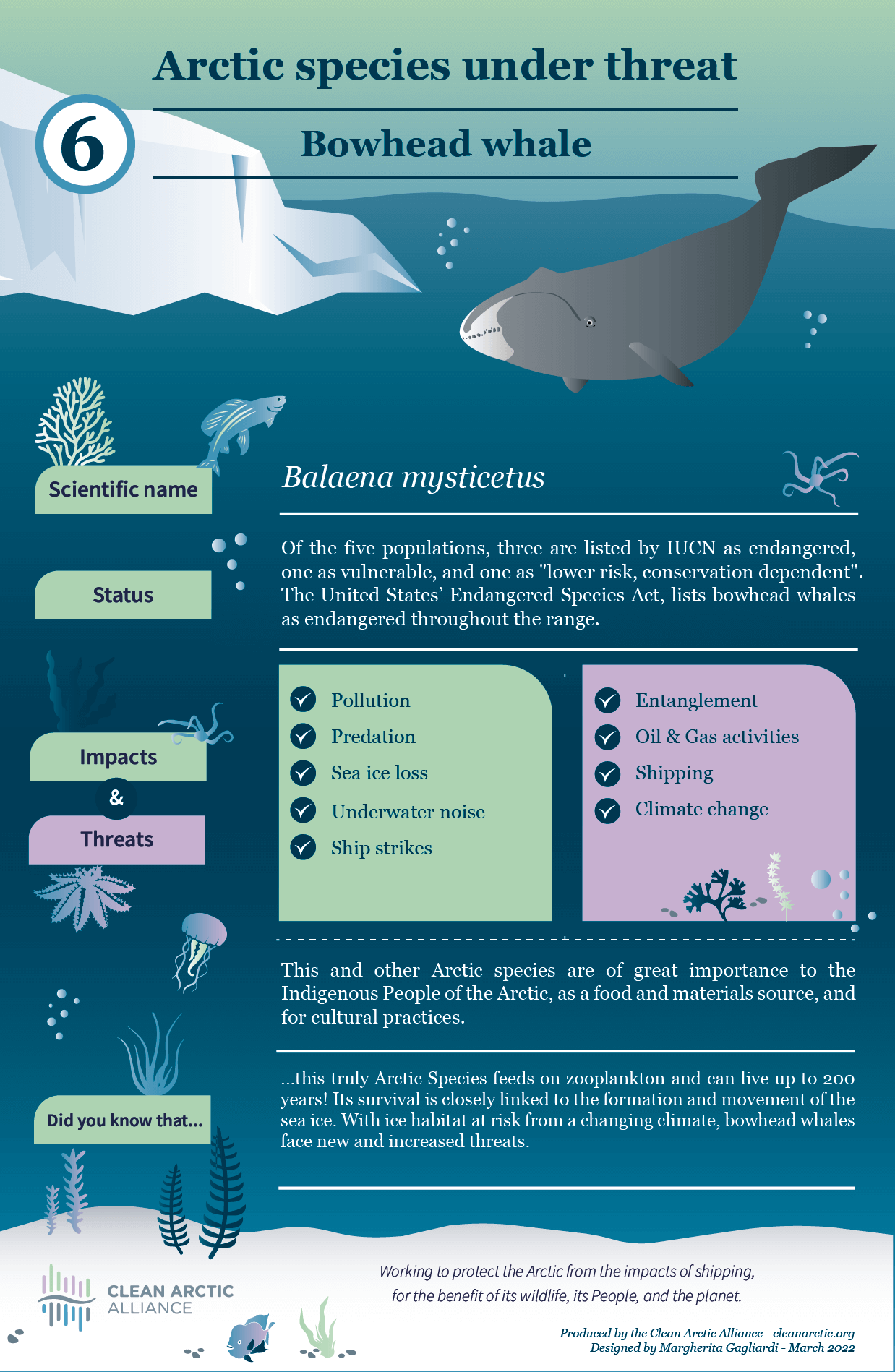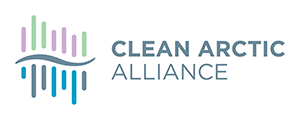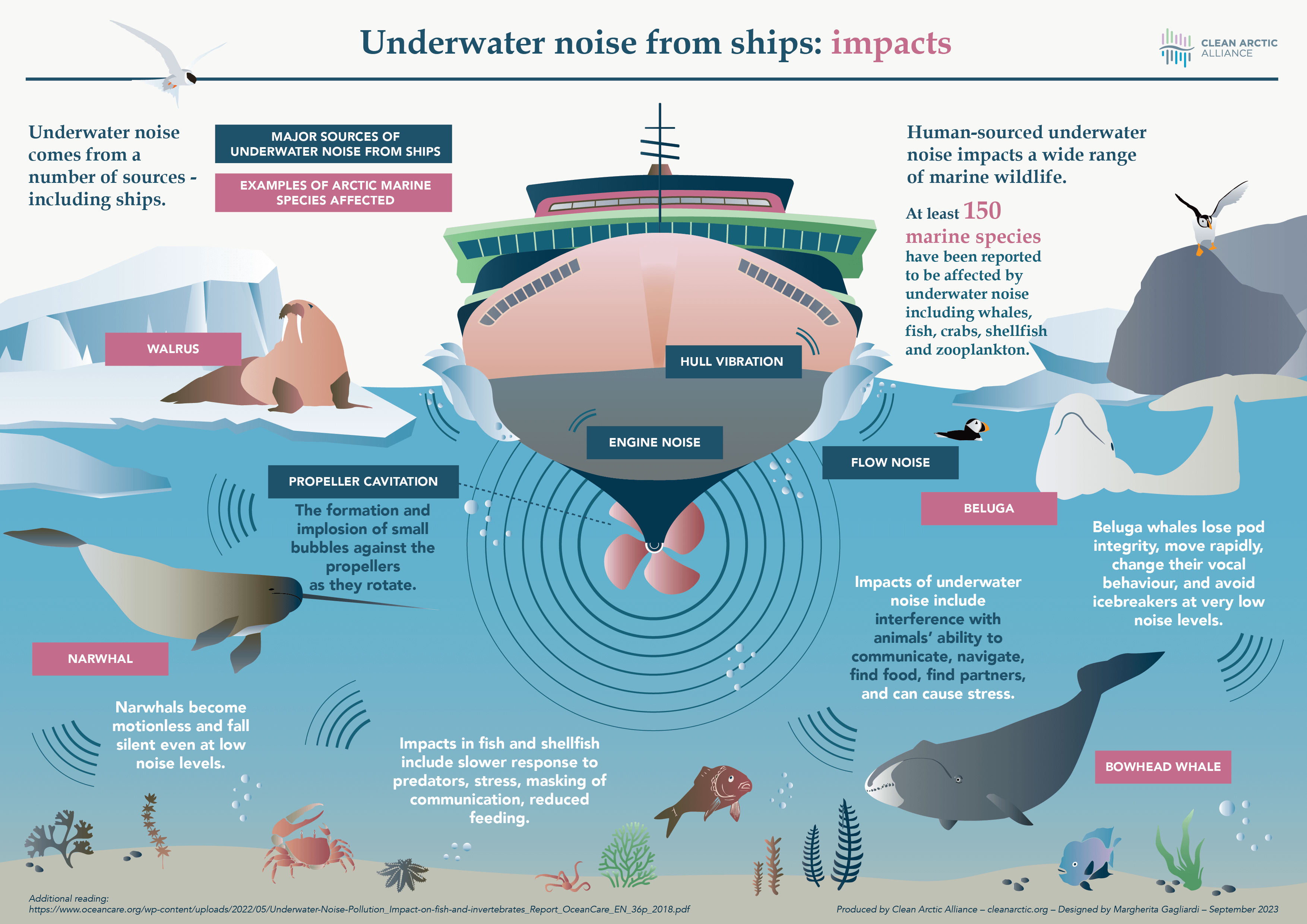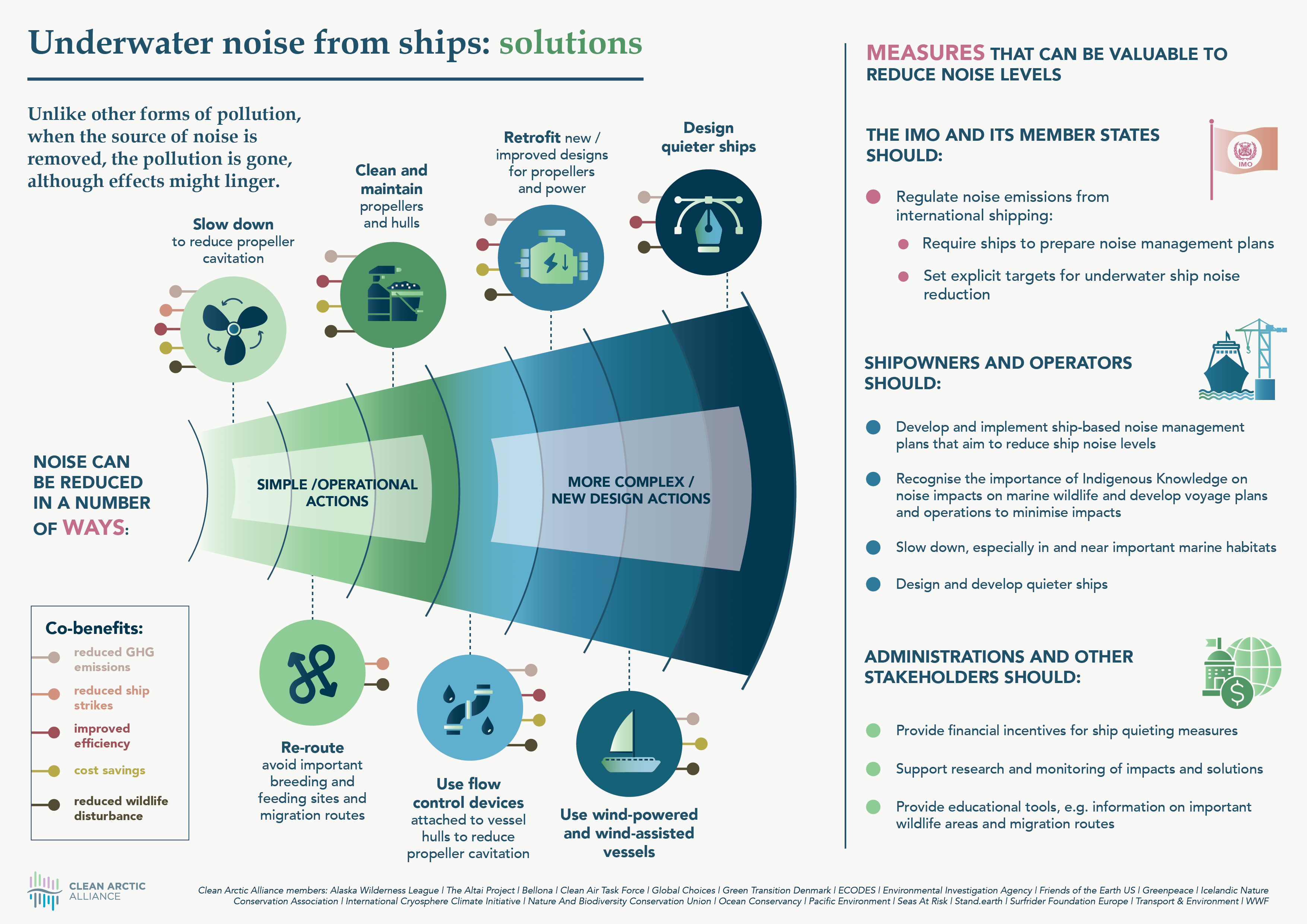The IMO must this week agree on an effective program of action and next steps to mitigate underwater noise from ships
23 January 2023:- The Clean Arctic Alliance today called for urgent action to address the impact of underwater noise from ships on Arctic wildlife, as a meeting of the International Maritime Organization’s (IMO) Sub-Committee on Ship Design and Construction opens in London (SDC 9, 23-27 January) [1].
A previous IMO meeting, MEPC 76 in June 2021, tasked the Ship Design and Construction (SDC) Sub-committee with revising the IMO’s 2014 Guidelines on the Reduction of Underwater Noise from Shipping, and to identify next steps and a program of action to further prevent and reduce underwater noise [2,3]. Subsequent work of the SDC committee identified the barriers that have limited the uptake and implementation of the 2014 guidelines – chief among these barriers is the non-mandatory nature of the guidelines.
See NGO paper: SDC 9/5/7 Review of the Guidelines for the Reduction Of Underwater Noise and Identification of Next Steps
“This week, the IMO must urgently address the impacts of underwater noise pollution on the health of marine wildlife, including whales, dolphins and fish”, said Clean Arctic Alliance Lead Advisor Dr Sian Prior. “Given the voluntary nature of the IMO’s underwater noise guidelines is the biggest barrier to their implementation, both the program of action and next steps identified by the committee during this week’s meeting must include recommendations for compulsory measures.”

“The non-binding nature of the current guidelines, which have not been updated since 2014, appears to have led to a de-prioritisation of the need for action by the shipping sector – and this is resulting in increasing noise levels in the ocean, including the Arctic – where underwater noise from increased shipping is having a much greater impact”, she added.
During this week’s meeting, a paper submitted by Canada (SDC 9/5/1) proposes that a working group be established during SDC 9 to complete the review of the guidelines, and to also focus discussions on prioritising the development of a program of action and identification of next steps to best reduce underwater noise [4]. This work could then be presented at MEPC 80 in July 2023.
A survey of the commercial shipping industry, conducted in 2019 by Environics Research and the World Maritime University, overseen by Transport Canada, the Chamber of Shipping of America, and WWF Canada, found that the non-regulatory/non-mandatory nature of the guidelines was a primary barrier to uptake. SDC 8, held in January 2022, a Working Group confirmed these findings when it agreed that the lack of regulations was a key barrier and was limiting uptake of the guidelines [5].
“Ultimately, the IMO must agree to the development of mandatory measures, such as the preparation and implementation of noise management plans for every ship, so that the overall failure to reduce underwater noise is addressed globally,” said Sarah Bobbe, Arctic Program Manager, at Ocean Conservancy.
“Some potential mandatory measures include requiring ships to develop and implement a Noise Management Plan, which is envisioned in the draft revised guidelines, and requiring ships to achieve quantitative underwater noise targets, which could be phased in over time, or reduced over some period of time, to achieve an overall reduction in ship-based underwater noise”, added Bobbe.
“A new study released in October 2022 confirmed that underwater noise from shipping continues to roughly double each decade in the ocean [6]. The voluntary guidelines were adopted by the IMO in 2014; over eight years of experience has shown that the voluntary guidelines have and will continue to fail to effectively mitigate the problem”, said Bobbe.
The Inuit Circumpolar Council’s submission (SDC 9/5/3) asks SDC to add a stand-alone section or annex to the guidelines related to operations in the Arctic which the Clean Arctic Alliance supports, and also suggests the Sub-Committee consider mandatory measures within the program of action [7]. This proposal for an Arctic annex is a direct result of work coming out of the Correspondence Group on the Review of the Underwater Noise Guidelines, which was instructed to: “enable engagement of Inuit and other Indigenous communities and the incorporation of Indigenous Knowledge” in the updating of the guidelines [8].
“In addition to global measures, even more stringent regional measures to reduce acoustic pollution from vessels in areas such as the Arctic will be necessary”, continued Bobbe. The Arctic is a special case for underwater noise because of how sound propagates over long distances, and how it can impact marine life and in turn, the Inuit communities who depend on wildlife and the sea for livelihoods and culture.”
“Some IMO member states are now moving towards regulating underwater noise in their waters, which risks leading to differing sets of regulations throughout the ocean, creating a lack of clarity and certainty for the shipping industry”, said Prior.
“For example, the EU’s Marine Strategy Framework Direction includes a descriptor for continuous underwater noise and requires underwater noise to be at such a level that it will not have adverse effects on marine ecosystems [9].”
“Inclusion of recommended mandatory measures in a programme of action agreed this week would signal interest from IMO member states in levelling the playing field and help lead to the creation of a singular set of expectations for industry to follow, while a global regulation would also ensure that countries that care about reducing the impact of underwater noise pollution on sensitive marine life won’t be penalised for regulating commercial shipping noise in their waters”, Prior concluded.
About Underwater Noise
For many marine organisms sound is the most important means of communication. Under water, vision is very restricted and without good hearing ability, elementary functions such as navigating, finding prey and partners can be hampered. This is of particular importance for marine mammals.
The Arctic has been almost free of anthropogenic sound for a long time, but with increased human activity, the Arctic Ocean is becoming more noisy every year. An important source of continuous underwater noise is shipping, more specifically the propeller and the engine. Since shipping has increased substantially during the last couple of decades, underwater noise is becoming an increasing problem, contributing to serious impact on the Arctic ecosystem. A number of Arctic species including the narwhal and beluga whales are particularly sensitive to anthropogenic noise.
“The most important source of continuous underwater noise in shipping is cavitation, or production of vacuum bubbles by propellers”, said Eelco Leemans, Clean Arctic Alliance technical advisor. “The noise emitted into the ocean overlaps with sound produced and used by marine mammals and makes it hard for these animals to communicate, to find food, and even to navigate. The easiest short term measure is to slow down and thereby reduce the cavitation effect, which would help in areas such as specific marine mammals habitats. Technical adjustments on propellers are also possible, currently research vessels and submarines have silent propellers.”
Watch video: Underwater Noise Webinar: Recent Innovations in Reducing URN from Ships (12 January 2022)
More on underwater noise on the Clean Arctic Alliance website.
Infographic: Arctic Species Under Threat
ENDS
Contact:
Dave Walsh, Communications Advisor, [email protected], +34 691 826 764
Notes:
SDC 9/5/7: Review of the Guidelines for the Reduction Of Underwater Noise and Identification of Next Steps: Submitted by FOEI, WWF, IFAW, Pacific Environment and CSC
January 2022: NGOs Welcome Initial Steps But Demand Greater Urgency On Reducing Underwater Noise Pollution and its effect On Marine Life
[1] Sub-Committee on Ship Design and Construction (SDC), 23-27 January 2023
https://www.imo.org/en/mediacentre/MeetingSummaries/Pages/Default.aspx
[2] Marine Environment Protection Committee (MEPC 76), 10 to 17 June 2021 (remote session)
https://www.imo.org/en/MediaCentre/MeetingSummaries/Pages/MEPC76meetingsummary.aspx
[3] Guidelines For The Reduction Of Underwater Noise From Commercial Shipping To Address Adverse Impacts On Marine Life (2014)
[4] SDC 9/5/1: Review of the Guidelines for the Reduction of Underwater Noise from Commercial Shipping to Address Adverse Impacts on Marine Life and Identification of Next Steps
SDC 9/5/7: Review of the Guidelines for the Reduction Of Underwater Noise and Identification of Next Steps: Submitted by FOEI, WWF, IFAW, Pacific Environment and CSC
[5] NGOs Welcome Initial Steps But Demand Greater Urgency On Reducing Underwater Noise Pollution and its effect On Marine Life
SDC 8-14-1 – Scoping document on Underwater Noise from Commercial Shipping (Paragraph 4 quotes Environics study)
[6] Underwater noise emissions from ships during 2014–2020, Environmental Pollution, Volume 311, 15 October 2022, 119766
https://www.sciencedirect.com/science/article/pii/S0269749122009800
[7] SDC 9/5/3: Comments on document SDC 9/5 – Report of the Correspondence Group on the Review of the Underwater Noise Guidelines
SDC 9/5/7: Review of the Guidelines for the Reduction Of Underwater Noise and Identification of Next Steps: Submitted by FOEI, WWF, IFAW, Pacific Environment and CSC
[8] SDC 9/5: Report of the Correspondence Group on the Review of the Underwater Noise Guidelines
SDC 9/5/7: Review of the Guidelines for the Reduction Of Underwater Noise and Identification of Next Steps: Submitted by FOEI, WWF, IFAW, Pacific Environment and CSC
[9] EU’s Marine Strategy Framework Direction: D11 Commission Decision (EU) 2017/848 of 17 May 2017
https://mcc.jrc.ec.europa.eu/main/dev.py?N=29&O=140&titre_chap=D11%20Energy%20and%20Noise
About the Clean Arctic Alliance
Made up of 20 not-for-profit organisations, the Clean Arctic Alliance campaigns to persuade governments to take action to protect the Arctic, its wildlife and its people.
Members include: The Altai Project, Alaska Wilderness League, Bellona, Clean Air Task Force, Green Transition Denmark, Ecology and Development Foundation ECODES, Environmental Investigation Agency, Friends of the Earth US, Global Choices, Greenpeace, Iceland Nature Conservation Association, International Cryosphere Climate Initiative, Nature And Biodiversity Conservation Union, Ocean Conservancy, Pacific Environment, Seas At Risk, Surfrider Foundation Europe, Stand.Earth, Transport & Environment and WWF.
More more information visit https://www.cleanarctic.org/



